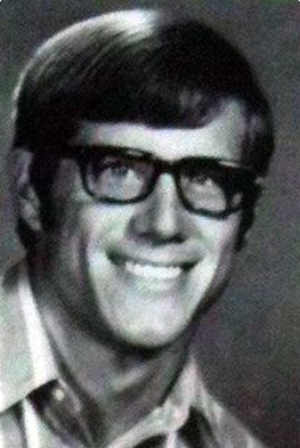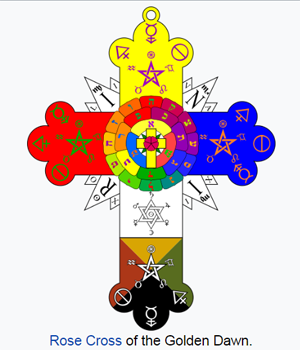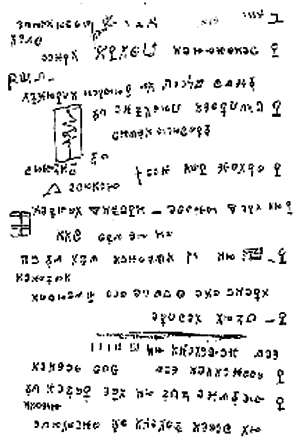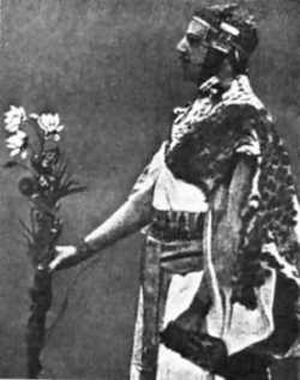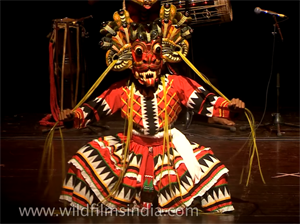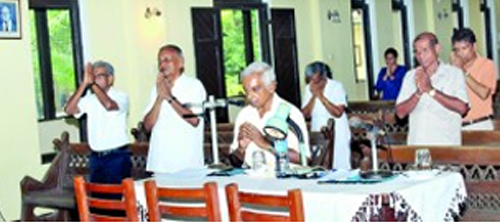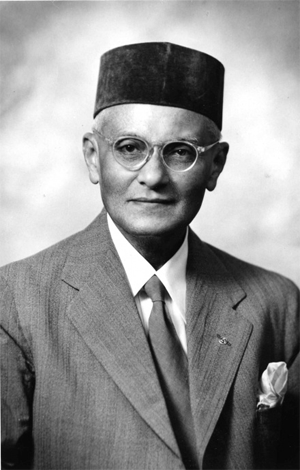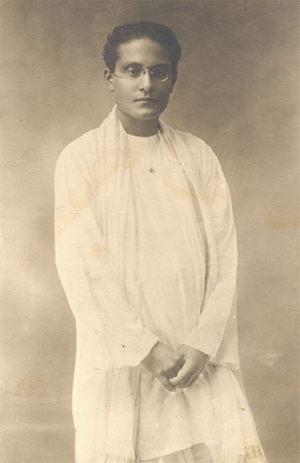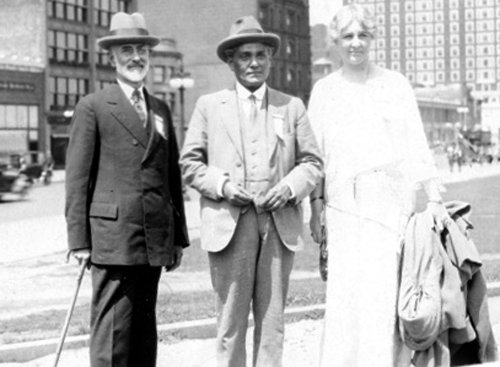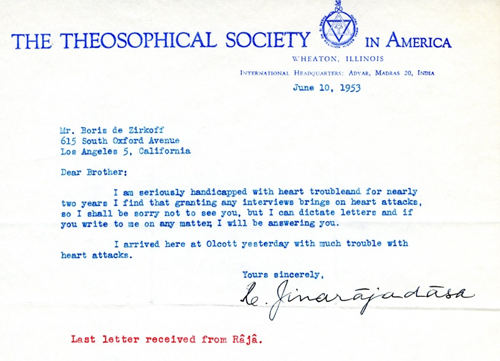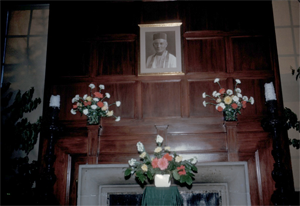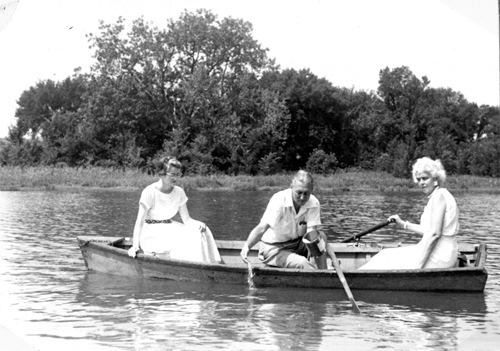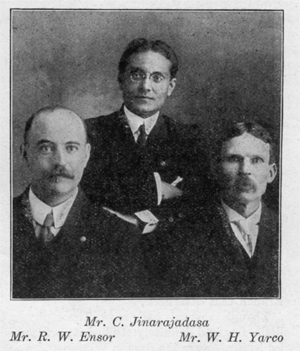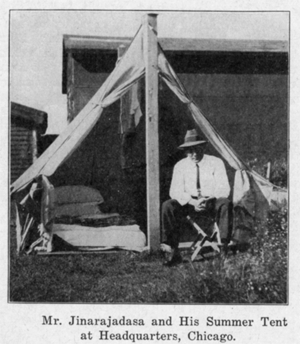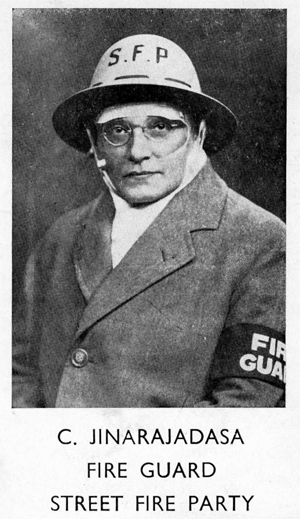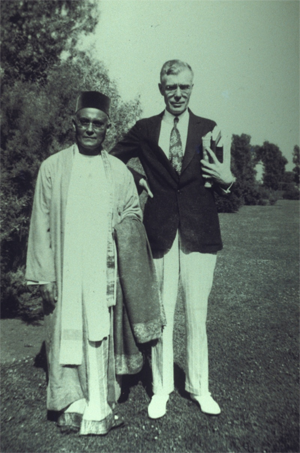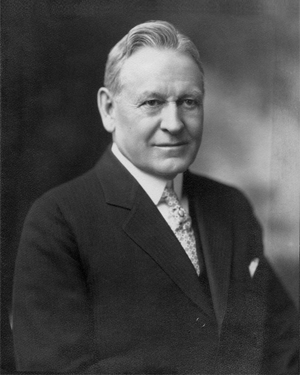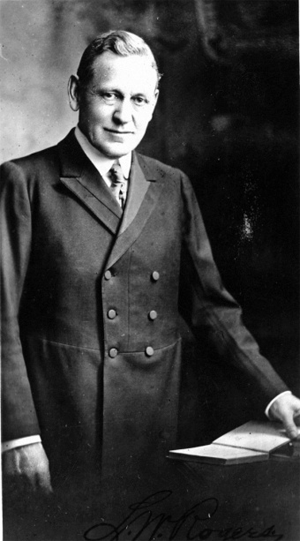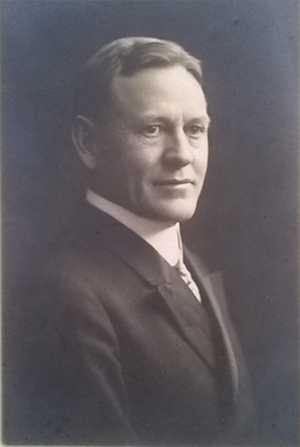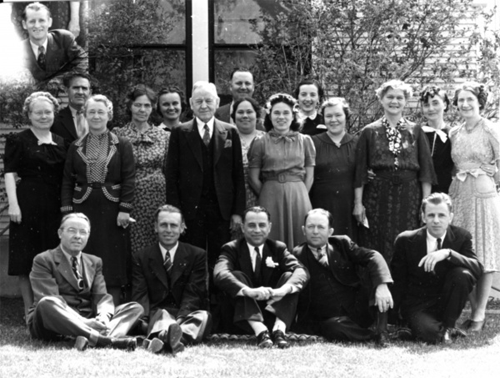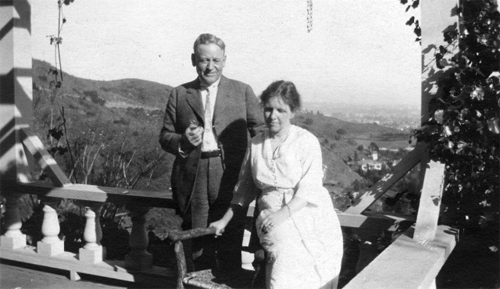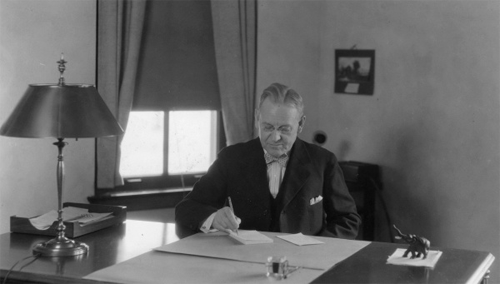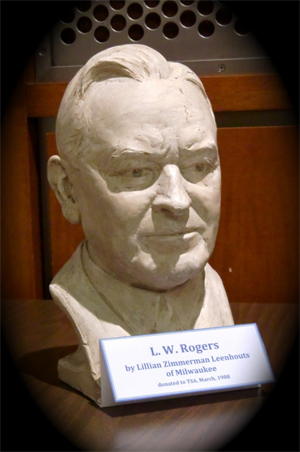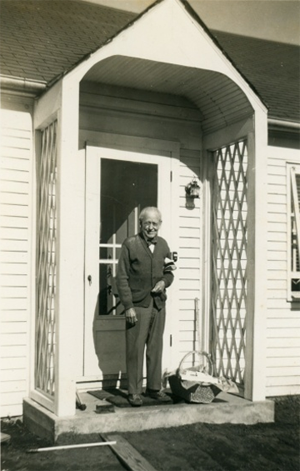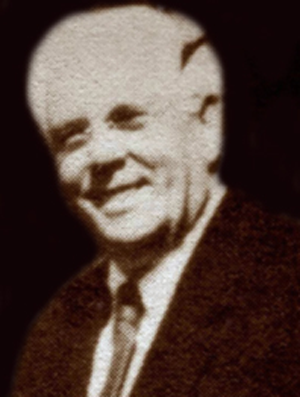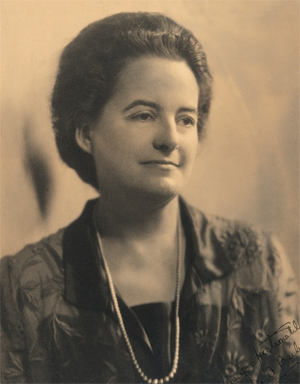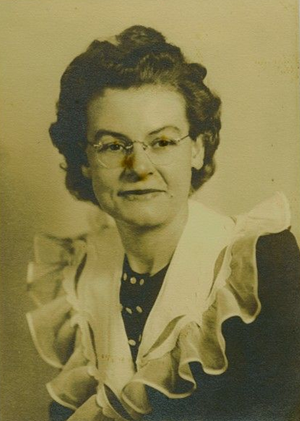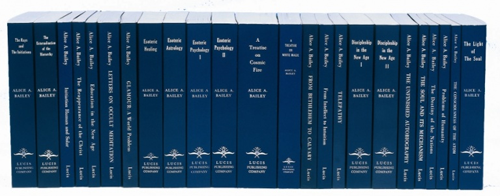Re: Freda Bedi, by Wikipedia
Charles Henry Allan Bennett
by Wikipedia
Accessed: 10/17/19
NOTICE: THIS WORK MAY BE PROTECTED BY COPYRIGHT
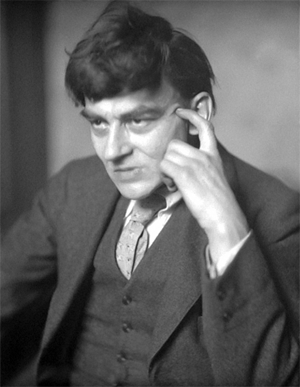
Charles Henry Allan Bennett (8 December 1872 – 9 March 1923) was a member of the Hermetic Order of the Golden Dawn. He was a close associate of author and occultist Aleister Crowley.
Bennett received the name Bhikkhu Ananda Metteyya at his ordination as a Buddhist monk and spent years studying and practicing Buddhism in the East. He was the second Englishman to be ordained as a Buddhist monk (Bhikkhu) of the Theravada tradition [1] and was instrumental in introducing Buddhism in England. He established the first Buddhist Mission in the United Kingdom.
Early life
Allan Bennett was born in London on 8 December 1872. His father, a civil engineer, died when he was still a boy. He was raised as a strict Roman Catholic by his mother; a faith which he had rejected whilst in his teens. There is reference to his having at least one sister. He was educated at Hollesley College and later at Bath, England. Upon leaving school, he trained as an analytical chemist and achieved some success in that field for he was invited to participate in an expedition to Africa by Dr. Bernard Dyer, chemist to the Corn Trade; however, he did not go in the end. His electrical knowledge was profound while still in his early twenties; this and his talent for experimental science, mathematics and physics would stay with him throughout his life.
Golden Dawn
Bennett was, along with George Cecil Jones, Crowley’s primary teacher during his days in the Hermetic Order of the Golden Dawn. Bennett was educated at Hollesly College, and scraped by as an analytical chemist. Bennett was initiated into the G.D. in 1894, taking the motto "Iehi Aour" ("let there be light"). He was always very poor and tormented by illness, but still made a strong impression on other occultists of the time.
Bennett was one of the most brilliant minds in the order, and favored mysticism and white magic; he was almost wholly concerned with enlightenment rather than siddhis (magical powers). Bennett had high regard for Golden Dawn leader S. L. Mathers, and with him began working on a book of Hermetic Qabalah correspondences that Crowley would later expand upon as Liber 777.
Soon after meeting, Crowley invited Bennett to come stay with him, as Bennett was living in a dilapidated shared apartment. In return, Bennett trained Crowley in the basics of magic and tried to instill a devotion to white magic. Bennett was generally ascetic and sexually chaste, a marked contrast to Crowley’s libertine attitude. Nevertheless, he was an enthusiastic user of mind changing drugs (with which he treated recurrent asthma) and introduced Crowley to this aspect of his occult researches.[2] Crowley once remarked concerning Bennett’s powers: Bennett had constructed a magical wand out of glass, which he carried with him. Crowley himself stated it to look similar in appearance to a chandelier. As it so happened, Crowley and Bennett were walking along one day and came across a group of theosophists who were ridiculing the use of wands. "Allan promptly produced his and blasted one of them. It took fourteen hours to restore the incredulous individual to the use of his mind and his muscles."
Travel to Southeast Asia
At some time between 1889 and 1900, in his late twenties, Bennett traveled to Asia[3][4] to relieve his asthma, and to dedicate himself to Buddhism. First he traveled to Ceylon where he studied Hatha Yoga under the yogi Shri Parananda. He joined the Sangha and took the name Swami Maitrananda.[5] Later, in Burma, Bennett took the vows of a Buddhist monk, and assumed the name Ananda Metteyya, "Bliss of loving kindness." In 1902 Crowley came to visit him there and was instructed in Hatha Yoga. At this time both men were agreed as to the validity of Buddhist practices. In 1903 he founded the Buddhasasana Samagama or the International Buddhist Society in London, UK (not to be confused with the International Buddhist Society in British Columbia, Canada). Bennett later began a periodical called Buddhism: An Illustrated Review.
Death
Some sources say that Bennett intended to travel to California due to health reasons. But with the outbreak of World War I and the denial of an immigration visa by the US, he found himself stranded, and forced to live in poverty and illness. He died on his native English soil at the age of 51, on 9 March 1923, buried at Morden cemetery. His lifelong friend and Buddhist writer, Dr Cassius Pereira, wrote: "And now the worker has, for this life, laid aside his burdens. One feels more glad than otherwise, for he was tired; his broken body could no longer keep pace with his soaring mind. The work he began, that of introducing Buddhism to the West, he pushed with enthusiastic vigour in pamphlet, journal and lecture, all masterly, all stimulating thought, all in his own inimitably graceful style. And the results are not disappointing to those who know."[6]
Legacy
Allan Bennett was a pioneer, and without him, Buddhism would not have entered the Western world as it did. He wrote two books: The Wisdom of the Aryas (1923)(based in part on a series of discourses in Clifford Bax's studio in 1919 and 1920[7]) and The Religion of Burma (1911, reprinted in 1929 by Theosophical Publishing House as The Religion of Burma and Other Papers). Some of his addresses and papers are still intact and used today.
Notes
1. Batchelor, Stephen The Awakening of the West, p. 40.
2. Symonds p18
3. Humphries C, Ananda Metteyya: With Some Observations on the English Sangha, The Middle Way Nov 1972:133-136.
4. Crow J (University of Amsterdam), The Bhikku and the Magus, Conference 2008
5. Golden Dawn Biographies, Allan Bennett Archived 11 May 2008 at the Wayback Machine
6. D r Elizabeth J Harris, Ananda Metteya, the First British Emissary of Buddhism, The Wheel Publication No.420/422 1998 ISBN 955-24-0179-8. (She is citing The Buddhist, 28 April 1923, p.6.)
7. See page 290(Sec XX) of Inland Far, by Clifford Bax, 1925
References
• Brunton, Paul A Pioneer Western Buddhist.
• Crow, John L. The Bhikkhu and the Magus, Exploring Bennett’s Influence on Crowley.
• Crowley, Aleister. Confessions of Aleister Crowley, Chapters 27–33.
• Fernando, Tilak S. World Buddhist Foundation in London Celebrates the United Kingdom Buddhist Day.
• Free Encyclopedia of Thelema. Allan Bennett. Retrieved 5 March 2005.
• Harris, Elizabeth J. Ananda Metteya: The First British Emissary of Buddhism.
• Symonds, John. The Great Beast, London, 1951
External links
• Xristos, Fra. Petros(7=4) Allan Bennett (1872-1923).
• Order of the Golden Dawn Allan Bennett 1872 - 1923.
****************************
Allan Bennett
by AstrumArgenteum.org
Accessed: 10/17/19
NOTICE: THIS WORK MAY BE PROTECTED BY COPYRIGHT
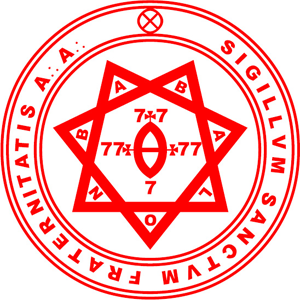

Alan Bennett (8th December 1872 – 9th March 1923)
Charles Henry – Allan Bennett was born in London on the 8th December 1872. His father, who was an engineer passed when he was still a young boy and was raised by his mother as a strict Roman Catholic. Like Crowley, Bennett suffered from severe asthma and would use a wide variety of drugs to combat it but it would haunt him his entire life which was unfortunately cut short when he died at the age of 51 due to a bowel obstruction.
In 1893 Bennett joined the Theosophical Society which he was a member of until 1895. In 1894 he also took initiation in the Hermetic Order of the Golden Dawn, taking the motto Frater Iehi Aour which means “let there be light.” He left a profound impression upon his superiors in the Order and within a year’s time would enter the Golden Dawn’s Second Order. Shortly thereafter (in 1898) Crowley joined the Golden Dawn and it is here that the two first met.
At the time Bennett struggled financially and lived in sub-par conditions. So Crowley invited Bennett, who he was very much drawn too – to live with him. Bennett would agree and hence began there long and fruitful friendship.
A couple of years later Bennett would travel to Southeast Asia, primarily in the hope that it would improve his health but also to study Buddhism. He moved to Ceylon (modern Sri Lanka) to study Yoga under the Yogi Shri Parananda. Crowley visited him several times during this period and Bennett would introduce Crowley to a number of practices.
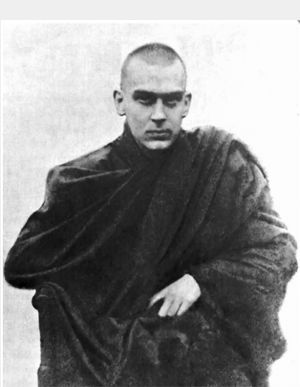
It was during one of these visits that the two went for an extended retreat to practice Yoga together and Bennett came to the conclusion that Buddhism was indeed his calling. In December Bennett relocated to Burma in order to become a novice within Theravada Buddhism and by February of 1902 Bennett took his Bhikkhu ordination which made him the second Englishman ever to become a Theravada monk. At his Ordination he assumed the name Ananda Maitreya (meaning “Bliss of loving kindness”) but would later change it to the Pali version, Ananda Metteyya. (Matteya being a future incarnation of Buddha).
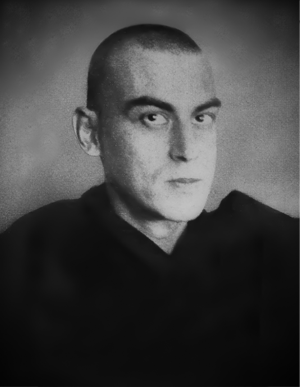
Just after his ordination Crowley would again visit and the two discussed how they could bring Buddhism to the west. Crowley fondly recollects this visit in his “Confessions”. These visits and Bennett’s instructions would serve as a catalyst in Crowley’s spiritual development
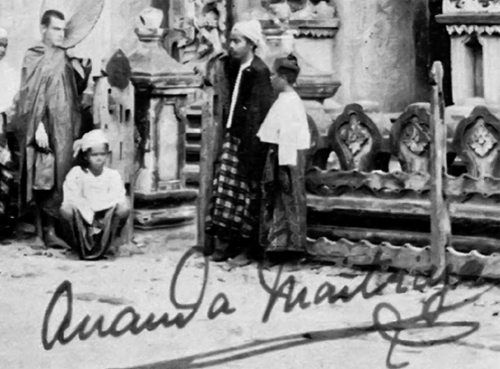
Bennett then went on to establish the International Buddhist Society, the Buddhasasana Samagama, in 1903. He began to publish pamphlets and a quarterly journal in English speaking countries with the goal of establish a Buddhist Sangha in England. In April of 1908 he returned to England to do just this and helped establish the Buddhists Society of Great Britain and Ireland. Bennett would eventually publish two books The Religion of Burma (1911) and The Wisdom of the Aryas (1923).
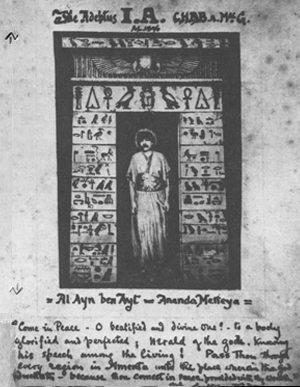
Though not officially a member of A∴A∴ as we know it Bennett would significantly influence Crowley’s thinking not just in regard to Buddhism but also in regard to Yoga, Pranayama and several other meditative practices whose techniques Crowley continued to utilize and teach throughout his life. Notably, Crowley’s teachings in regard to the Magical Memory stem from what Bennett taught Crowley during this period.
Crowley also included one of Bennett’s essays, “The Training of the Mind” in the Equinox Vol 1 no. 5 and would expand upon Bennett’s Qabalistic dictionary Sepher Sephiroth which is now listed as an official publication of the A∴A∴ given in Class B.
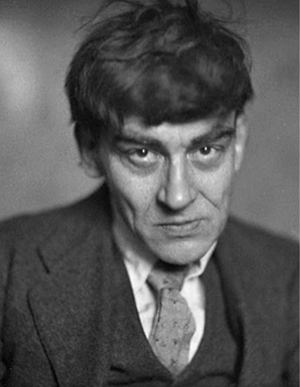
In his essay “The Training the Mind” Bennett describes how meditation can cultivate Right Concentration. However, what few people know is that Bennett did not write this essay for inclusion in the Equinox – Instead it was originally published in as a pamphlet for Bennett’s organization, the International Buddhist Society in 1908 and was entitled “On the Culture of Mind” which Crowley simply renamed and published in the Equinox, clearly demonstrating that Crowley still highly regarded these teachings.
For further reading on Allan Bennett, please visit our Library.
****************************
Allan Bennett
by George Knowles
© George Knowles September 9, 2016
NOTICE: THIS WORK MAY BE PROTECTED BY COPYRIGHT
The name of Charles Henry Allan Bennett is little known today, but during his time he was an accomplished highly regarded British occultist. He was an early member of the Hermetic Order of the Golden Dawn and a one time friend, teacher and mentor to the infamous Aleister Crowley. Allan Bennett later abandoned Western occult traditions in favour of Eastern mystery traditions. In the early 1900’s he travelled to Ceylon (now Sri Lanka) then on to Burma (now Myanmar) where he became ordained a Buddhist Monk. He founded the International Buddhist Society in 1903, and did much to introduce and promote Buddhism to the West, particularly here in the United Kingdom.
Allan Bennett was born in London in on 08th December 1872. His father, a civil and electrical engineer, passed away while he was still young and so he and a sister were raised by his mother, a strict Roman Catholic. From a very early age Bennett suffered frequently with acute asthma, an affliction that would leave him debilitated for weeks on end, during those periods while his mother worked and struggled to support the family, his sister would stand in for her taking care for him. His sister later emigrated and went to live in California, USA.
Bennett’s early educated began at the Colonial College in Hollesley Bay, Suffolk, then later continued in Bath, Somerset, where he showed a marked propensity for scientific research, particularly in the fields of electricity and chemistry. After leaving school he first trained as a chemical analyst and later in 1894 was employed briefly by Dr. Bernard Dyer, an International Analyst and Consulting Chemist based in London who worked as an official analyst to the London Corn Trade. That same year Bennett was invited to participate in a scientific expedition to Africa, but this he declined do, due mainly to his continuing ill health.
The chronic asthma that plagued him throughout his life also prevented him from holding down a permanent job, as half of the time he was heavily doped up on a rotation of prescribed drugs, such as: opium, cocaine, morphine and chloroform, courses of which often left him debilitated recovering in bed. While he was also an accomplished research electrician and conducted experiments on a variety of his own electronic inventions, none of these proved successful enough to provide an adequate living. This meant that for most of his early adult life he lived close to poverty living in London’s cheap and dingy slum districts of Southwark and Lambeth.
During his youth and into his teens Bennett was raised a devout Roman Catholic, but at the age of 16 as his keen scientific mind and quest for new research expanded, so to did he seek to expand his growing sense of spirituality. He therefore rejected Catholicism as incompatible with science in favour of the more arcane philosophies and theologies of the Western occult traditions and Eastern mystical religions of Hinduism and Buddhism. He also studied Spiritualism and other esoteric practices.
To quote from Aleister Crowley his later friend and student, at the age of 18 Bennett read Edwin Arnold’s poem “The Light of Asia” (published 1897, an early translation of a Buddhist text), which had a profound influence on his later life, for at that time Buddhism was little known in the West. He had also made a study of Hinduism, and once while practising a yogic form of breath control and trance meditation, he gained “Shivadarshana”, which Crowley describes as: “.... an extraordinarily high state of yogic attainment.” During the trance he is said to have experienced a blissful communion with Shiva, the Hindu god of Yoga, and resolved to dedicate the rest of his life to recapturing similar states of communion.
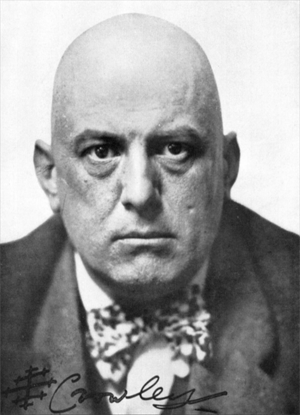
Aleister Crowley
As he continued to explore alternative religions and spiritualities, Bennett joined two of the UK’s leading occult organisations. On the 24th March 1893, he joined the “Theosophical Society”, co-founded by Helena Petrovna Blavatsky and Colonel Henry Steel Olcott in 1875, an occult philosophical society based on Eastern religious mysticism and theology. Through the Society he attended courses and lectures on yoga, mediation, consciousness and reincarnation, while at the same time studying Blavatsky’s “The Secret Doctrine”. The Society also had a strong connection to Buddhism, as both the co-founders had declared themselves Lay-Buddhists in Ceylon (now Sri Lanka) in 1880.
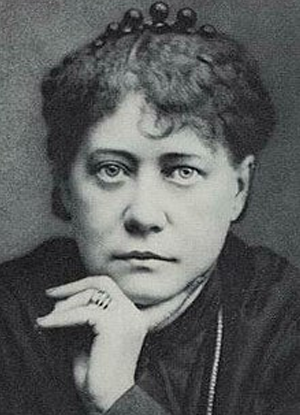
Helena Petrovna Blavatsky
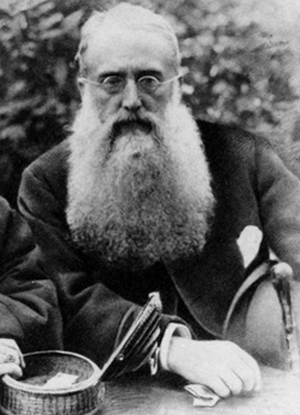
Colonel Henry Steel Olcott
The second important organisation he joined was the “Hermetic Order of Golden Dawn”, founded in 1888 and based on Western esoteric teachings such as the Kabbalah (Jewish mysticism - spelt variously as Cabbala or Qabalah), Astrology, Alchemical symbolism, Geomancy and the Tarot. When Bennett joined in February 1894 he was initiated into the first/outer Order as a Neophyte, taking the motto: “Voco” (Latin for “I call”). Just a year later on the 22nd of March 1895 he was raised to Adeptus Minor in the higher second/inner Order taking the motto: “Iehi Aour” (Hebrew for “Let there be light”). There he joined S.L. MacGregor Mathers and Dr. William Wynn Westcott, two of the original three ruling Chiefs and co-founders of the Order. The third Dr. William Woodman had passed away on the 25th February 1892.
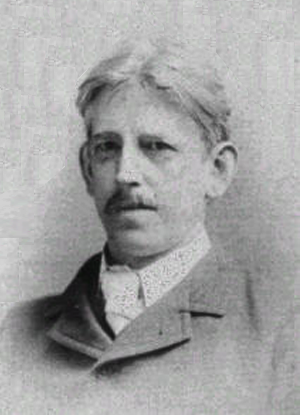
S.L. MacGregor Mathers
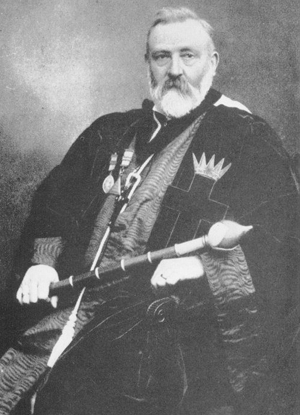
Dr. William Wynn Westcott
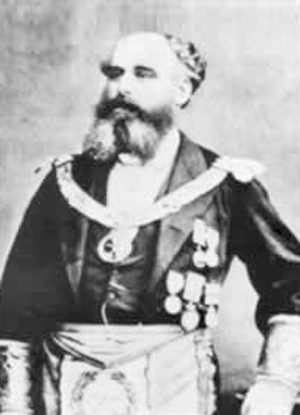
Dr. William Woodman
Bennett quickly gained a reputation as a powerful Magus and Cabalist matching the magical abilities of S.L. MacGregor Mathers, who had created most of the Order’s teachings and rituals. Crowley tells a story of how Bennett had a special wand (called a blasting rod):
When not doped up on medications (see use of drugs above) Bennett had one of the most brilliant magical minds in the Order, but he favoured mysticism rather than magical powers and was mostly concerned with enlightenment. However, Bennett had a high regard for the Order’s main magical Chief - S.L. MacGregor Mathers, and being mostly out of work due to ill health, began working with Mathers collating and editing material for the Order’s curriculum, including much of the Hermetic Cabbala correspondences that Aleister Crowley later expand upon in his book “Liber 777.”
Crowley first met Bennett in February 1899 after he (Crowley) had joined the Order on the 18th November 1898, and states his first impression of Bennett was that he possessed: “.... a tremendous spiritual and magical force.” Soon after their first meeting, Crowley learned that Bennett was living in a dilapidated shared apartment, and so invited him to stay at his luxury flat at 67/69 Chancery Lane. They’re Bennett began to teach Crowley the basics of ritual magick and yoga. Crowley goes on to describe Bennett as:
Toward the end of 1899 Bennett’s health became so bad that many of his friends feared for his life and recommended he leave England for a warmer climate to convalesce and recuperate. Crowley who had ample funds would have been more than happy to pay for such a move, but was restrained believing that Bennett would have declined such an offer and take offence. While the magical community deemed sharing his flat and hospitality acceptable, for Bennett to accept monetary funding for such a move, might be seen as accepting payment for magical knowledge, and that was unacceptable. Instead Crowley persuaded a wealthy ex-mistress outside of the magical community to donate £100 to fund his move when he was ready.
By this time Bennett was leaning more and more toward Buddhism and the practice of yoga, but was becoming increasingly disillusioned by Mathers’ apparent antagonism toward “Orientalism”. The Golden Dawn was also in a shambles with membership declining as schisms over leadership threatened to break it apart. So with all that going on and now having funding in place for him to make a move, Bennett decided to go and dedicate the rest of his life to Buddhism. Early in 1900 he boarded ship and set sail for Ceylon (now Sri Lanka).
After his arrival in Ceylon Bennett spent his first six months in Kamburugamuwa, Matara, recuperating while studying Pali (the sacred language of Buddhism) under the Ven. Weragampita Revata, an elderly Sinhalese monk. As his health improved, so he was also able to give up most of the drugs he had been using in England, but then needing work to support himself, he moved to Kandy where he became a tutor to the son of the Hon. Ponnambalam Ramanathan, the Solicitor-General of Ceylon. There Ramanathan, who was also a well known yogi by the name of Sri. Parananda began to instruct him in the techniques of Hatha Yoga, such things as the Asanas (physical postures) and Pranayama (breathing techniques for meditation).
In July 1901, Bennett presented his first lecture on Buddhism entitled “The Four Noble Truths” to the Hope Lodge of the Theosophical Society in Colombo. It was here that he first met Dr. Cassius Pereira (later the Ven. Kassapa Thera) who was so impressed by his lecture; he became a life-long friend and supporter.
A shortly time later while on a trip to Ceylon, Aleister Crowley paid him a visit and they shared a house together in Kandy called ‘Marlborough’. There Bennett taught him more advanced techniques of yoga and meditation in preparation for Ritual Magic. By this time his own yogic attainments were impressive and he was able to meditate for days at a time in Padmasana, the so-called “lotus posture,” which according to Crowley is extremely difficult to master. Crowley records one incident that happened in Kandy:
Crowley also notes that Bennett fed leeches every morning with his own blood, and could control their ability to penetrate his skin by controlling his breathing, or vital prana (“life force” or “life energy”)
By the end of 1901 Bennett determined to become a Buddhist monk and join a Sangha (a Buddhist monk community), but felt that Ceylon was not the right place for him to do so. Instead he traveled to Akyab (now Sittwe), located on the west coast of Burma (now Myanmar), and on the 12th December 1901 gave up all his personal possessions and joined the Theravada tradition of monks at the Buddhist monastery of Lamma Sayadaw Kyoung. There he received ordination as a sramanera (a novice) Bhikkhu (a male monastic monk) from Dr. Moung Tha Nu, taking the name Ananda Maitreya, later he changed his last name to Metteyya (a Pali meaning for “bliss of loving kindness”).
Crowley again visited Bennett in February 1902 and refers to him dressed in robes as: “.... seeming to be of gigantic height compared to the diminutive Burmese.” He also commented on the return of his troubling asthmatic affliction, and how his health had once again deteriorated due to a lack of proper medical attention and the damp cold air of his pre-dawn alms rounds. Bennett was determination to carry out the strict rules of the monastery, and as a new monk would not break any of the daily routines and accepted practices despite his increasing ill health.
Just six months later on the 21st May 1902 Bennett received upasampada (higher ordination as a full Bhikkhu) from the Ven. Sheve Bya Sayadaw, making him just the second person from the United Kingdom ever to be fully ordained as a Buddhist monk. He was now known as the “Venerable” (Ven.) Ananda Metteyya. The first person was an Irish-born Japanese Buddhist called Charles Pfoundes, born Charles James William Pounds to Irish Anglican parents in the South East of Ireland in 1840. In 1889 Pfoundes, led a Buddhist mission to London as a representative of the Japanese “Buddhist Propagation Society” founded in 1887, and after spending three years there promoting Buddhism, returned to Kobe, Japan in 1892, never again to return to Europe. He died there in 1907.
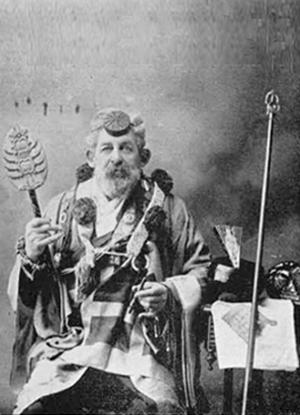
Charles Pfoundes
Following his higher ordination as a full Bhikkhu, Bennett (now the Ven. Ananda Metteyya) gave a speech to the assembled monks outlining his future goals and his mission to spread knowledge about Buddhism in the West. More particularly he wanted to create a Sangha in his home country England, UK. Bennett was later promoted to syadaw (a Pali word for a senior monk or abbot of a monastery) thus receiving the veneration of many devout Buddhists and acquiring a reputation as a distinguished holy man. Later he moved to another monastery in Rangoon (now Yangon in Myanmar), located about two miles from the city centre from where he began to plan his mission.
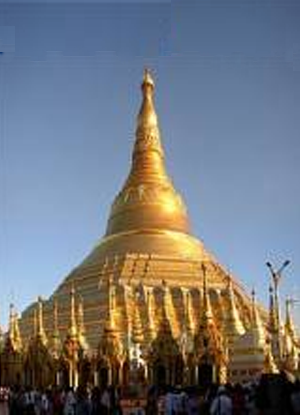
This is possibly (though not confirmed) where he moved to, the Shwezedi Monastery, a famous Theravada Buddhist monastery and one of the oldest in the world, which includes a gilded stupa known as the Great Dagon Pagoda.
In 1903 Bennett founded the “Buddhasasana Samagama” or “International Buddhist Society” with the aim of consolidating Buddhists all around the world. At the first meeting of the Society held on the 15th March 1903, the constitution and rules were implemented and officers elected. Bennett as Ven. Ananda Metteyya appears in the printed prospectus as the General Secretary, with Dr. E. R. Rost, a Westerner and member of the Indian Medical Service, as the Hon. Secretary. Later he produced a periodical called: Buddhism - An Illustrated Quarterly Review, edited by Bhikkhu Ananda Metteyya, the first volume of which was published on the 15th September 1903. While initially intended as a quarterly publication, only six issues of the Review were published between 1903 and 1908, this due mainly to his continuing health problems and apologies for delays appear in almost every issue.
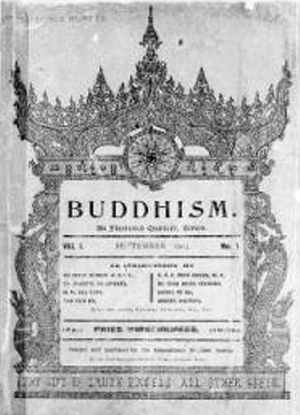
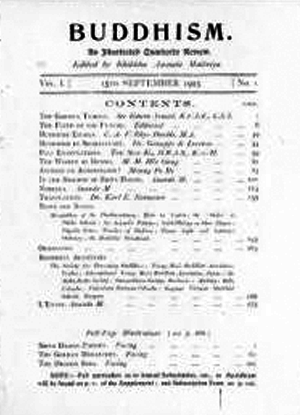
The first issue of Buddhism - An Illustrated Quarterly Review dated 15th September 1903
Thanks to donations from local Burmese people, issues of the Buddhism Review were sent out free to between 500 and 600 libraries across Europe and quickly established an intellectual readership. Through this Bennett was able to set-up a network of international contacts and scholars from all around the world who not only contributed to the Review, but also kept him up-to-date on latest developments in science, scholarship and politics effecting Buddhists in other countries. The International Buddhist Society also made ground with official representatives in Austria, Burma (Myanmar), Ceylon (Sri Lanka), China, Germany, Italy and America.
On the 03rd November 1907 a group of lay-Buddhists in England, UK, founded the “Buddhist Society of Great Britain and Ireland”, and at it’s first meeting on the 26th November elected a Pali scholar T.W. Rhys-Davids as it’s President. This paved the way for Bennett to return to England on a visit and launch his mission to spread word about Buddhism in the West from his home country. Bennett arrived in England for a six-month visit on 23rd April 1908 accompanied with a number of supporters, then returned to Burma on the 02nd October, which was all the time allotted for his Mission.
During his visit and despite his frequent bouts of asthmatic incapacity, Bennett did much to grow membership in the Society by giving a considerable number of talks, lectures and presentations about Buddhism around the country, including one on the 10th June to the Blavatsky Lodge of the Theosophical Society. Many of his lectures were later reprinted as pamphlets, promoting Buddhism far and wide. One such entitled “The Training of the Mind” was also re-published in The Equinox, Aleister Crowley’s main magazine and the vehicle for his own religious teachings ‘Thelema’.
During his visit, Crowley had tried to rekindle his friendship with Bennett, which had dwindled as each travelled along separate spiritual paths. Since their last meeting in Burma in 1905, and while travelling across the China/Burma border, Crowley had experienced a powerful samadhi (a state of intense concentration achieved through meditation, which in yoga is regarded as the final stage at which union with the divine is reached). This had proved a catalyst to Crowley’s further spiritual work, and he had moved on rejecting Buddhism in favour of his own Hermetic Tradition called Thelema. Bennett however would have nothing to do with it, and is quoted as saying: “No Buddhist would consider it worthwhile to pass from the crystalline clearness of his own religion to this involved obscurity”. What caused their initial falling out is not known, but it is clear through his own autobiography that Crowley maintained a deep respect for his early teacher and mentor.
After Bennett returned to Burma where the climate was better than that of England, the régime of his monastic lifestyle continued to cause him difficulty. First, tradition dictated he could only eat before noon each day, which generally kept him physically weak. Secondly, he routinely ventured out into the cold damp air at 06am each morning to collect alms, which only exasperated his continuing asthmatic condition. Despite these difficulties he was adamant in maintaining the strict rules imposed by the monastery and continued to write and promote Buddhism worldwide.
In Burma for instance aided with the support of others, he was successful in getting Buddhism taught in schools as a main-line religion equal to Catholicism, and in 1911 published his first book on Buddhism called The Religion of Burma (1911, reprinted in 1929 by the Theosophical Publishing House as The Religion of Burma and Other Papers). He also, whenever he could, he would travel to give talks, presentations and lectures wherever he was invited. In May 1912 he travelled back to Sri Lanka where his long-time friend and supporter Dr. Cassius Pereira (later known as Ven. Kassapa Thera) was opening a new Hall dedicated to the teachings of Buddha, and which he named Maitriya Hall in Bennett’s honour. At the inauguration of the Hall, Pereira records that Bennett gave “several inspiring addresses.”
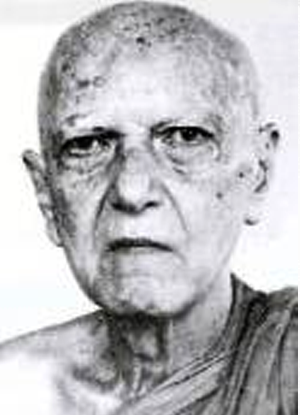
Dr. Cassius Pereir
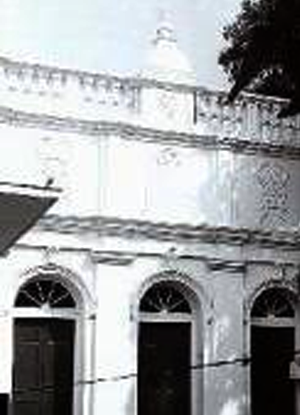
Maitriya Hall
Bennett had hoped to return to England within two and half years and continue his mission to set up his own Sangha, but this was not to happen. Indeed his health had continued to deteriorate. To further complicate matters, in December 1913, Dr. E. R. Rost performed two operations on him to remove gallstones, although the operations were successful, they did little to improve his general health. As a result his doctors advised him to change his régime or leave Burma for a more suitable climate. After talking things through with his sister in the United States, it was decided then that he should leave the Sangha at the monastery and travel to sunny California where she could better take care of him.
Arrangements were made for him to meet his sister in the following year in England while she was there visiting with friends, and then travel back with her to California. So in May 1914 Bennett, who had just been awarded the appellation of Thera (a Pali word for Elder), disrobed and returned to England to meet up with his sister. Their plan then was to board a ship in Liverpool on the 12th September and travel on to California. However when they arrived, the ships Doctor refused to allow him on board, stating his health was so bad the American authorities would not allow him a landing permit on health grounds. His sister therefore travelled on without him.
Bennett, now an ex-Buddhist, was left stranded, sick and with no place to live or stay, he therefore had to call on the charitable help of the Buddhist Society of Great Britain and Ireland, the same he had previously helped to promote on his last visit to England. Fortunately one member of the Liverpool Branch of the Society, a doctor, was able to take him in and for the next two years accommodated him and provided what medical care he needed.
By this time WW1 was escalating across Europe and as England continue to send troops into the conflict, austerity measures to support them deepened. As a result, the doctor in Liverpool could no longer afford to keep Bennett and so he returned to his old cheap accommodations in the slum areas of Southwark and Lambeth in London.
There he lived on supported by charity and donations received from friends in the British Buddhist Society, and other Buddhist overseas, particularly those in Burma and Sri Lanka who had heard about his plight.
Although at one stage his asthma attacks were occurring almost on a daily bases, by the winter of 1917 he was sufficiently improved as to give a series of six lecture presentations on Buddhism to a private selected audience gathered in the studio of Clifford Bax (a well known socially connected London writer, journalist, editor, playwright, poet and lyricist). Perhaps inspired by the lecture series, which were well received, when not incapacitated by his affliction, for Bennett they marked a return to his mission work, that of spreading and promoting Buddhism throughout the West and particularly in England.
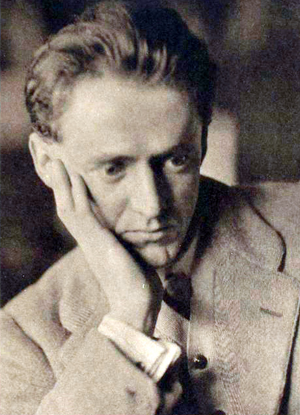
Clifford Bax circa 1916
In 1918 he once again began to contribute to the Buddhist Review, which after his last visit to the UK in 1908, and being unable to manage his original Buddhism Review, the Society of Great Britain and Ireland had taken it over, renamed it slightly and continued to produce it as the main voice and vehicle of Buddhism worldwide. Later in 1920 he reassumed his role as the main editor of the Review, began speaking at meetings organised by the Society, and also became actively involved in their future plans.
But time was beginning to run out for Bennett as his health again deteriorated. The January 1922 edition of the Buddhist Review was to be the last that he edited, indeed it was also the last that was published. His final act was to see the publication of his new book containing the six lectures he had given during the winter of 1917/18. These he had extended with an additional large introduction to Buddhism, and an essay on Transmigration, thought to be one of the most difficult of Buddhist teachings to make clear to the Western mind. The new book called The Wisdom of the Aryas, was published just two months before he died.
Allan Bennett died of an intestinal blockage at around 05.00pm on the 09th March 1923, he was just 51 years of age. At the time of his death he is reported to have been living in poverty in a single rented room in a multi occupied property at 90 Eccles Road, Clapham Junction. With no money of his own to afford a proper burial, and to save him from a pauper’s grave, a donation was received from Sri Lanka (most likely from Dr. Cassius Pereira) to purchase a plot in Morden Cemetery, South London. Members of the Buddhist Society of Great Britain and Ireland held a funeral service, which was officiated and prepared by Francis Payne, a convert from his earlier 1908 mission in England. After the service, flowers and incense were placed on the grave by a large gathering of other assembled members. Sadly however, no gravestone was ever erected in memorandum, so it remains today an unmarked grave.
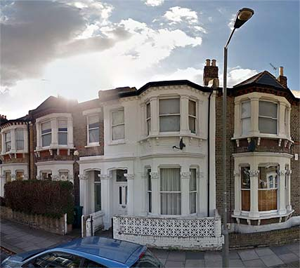
90 Eccles Road, Clapham Junction
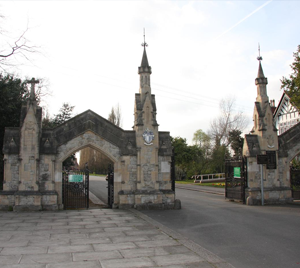
Morden Cemetery, South London (views today)
While no doubt the Buddhist Society of Great Britain and Ireland who had looked out for Bennett’s well-being through his final years and organised his funeral service, would have received many tributes and condolences about the sad passing of their leader. One such that stands out and best sums-up their loss was written by his long-time friend and supporter in Sri Lanka, Dr Cassius Pereira, who wrote:
May he rest in peace.
Sources:
The Confessions of Aleister Crowley - edited by John Symonds & Kenneth Grant 1969 (my edition Bantam Books 1971).
http://www.bps.lk/olib/wh/wh420.pdf
http://web.archive.org/web/200306281413 ... ry/18.html
http://www.island.lk/2007/12/27/features3.html
http://www.themystica.com/mystica/artic ... allan.html
https://en.wikipedia.org/wiki/Charles_H ... an_Bennett
http://www.golden-dawn.org/biobennett.html
http://www.lankaweb.com/news/items/2016 ... irca-1903/
Plus so many others, way too many to mention.
by Wikipedia
Accessed: 10/17/19
NOTICE: THIS WORK MAY BE PROTECTED BY COPYRIGHT
YOU ARE REQUIRED TO READ THE COPYRIGHT NOTICE AT THIS LINK BEFORE YOU READ THE FOLLOWING WORK, THAT IS AVAILABLE SOLELY FOR PRIVATE STUDY, SCHOLARSHIP OR RESEARCH PURSUANT TO 17 U.S.C. SECTION 107 AND 108. IN THE EVENT THAT THE LIBRARY DETERMINES THAT UNLAWFUL COPYING OF THIS WORK HAS OCCURRED, THE LIBRARY HAS THE RIGHT TO BLOCK THE I.P. ADDRESS AT WHICH THE UNLAWFUL COPYING APPEARED TO HAVE OCCURRED. THANK YOU FOR RESPECTING THE RIGHTS OF COPYRIGHT OWNERS.
-- Honour Thy Fathers: A Tribute to the Venerable Kapilavaddho ... And brief History of the Development of Theravāda Buddhism in the UK, by Terry Shine
-- Ananda Metteyya [Charles Henry Allan Bennett]: The First British Emissary of Buddhism [Excerpt], by Elizabeth J. Harris
-- Convert to Compassion: Allan Bennett, from Theravada Buddhism and the British Encounter: Religious, Missionary and Colonial Experience in Nineteenth Century Sri Lanka [Excerpt], by Elizabeth J. Harris
-- Charles Henry Allan Bennett, by Wikipedia
-- Allan Bennett, by AstrumArgenteum.org
--Allan Bennett, by George Knowles

Charles Henry Allan Bennett (8 December 1872 – 9 March 1923) was a member of the Hermetic Order of the Golden Dawn. He was a close associate of author and occultist Aleister Crowley.
Bennett received the name Bhikkhu Ananda Metteyya at his ordination as a Buddhist monk and spent years studying and practicing Buddhism in the East. He was the second Englishman to be ordained as a Buddhist monk (Bhikkhu) of the Theravada tradition [1] and was instrumental in introducing Buddhism in England. He established the first Buddhist Mission in the United Kingdom.
Early life
Allan Bennett was born in London on 8 December 1872. His father, a civil engineer, died when he was still a boy. He was raised as a strict Roman Catholic by his mother; a faith which he had rejected whilst in his teens. There is reference to his having at least one sister. He was educated at Hollesley College and later at Bath, England. Upon leaving school, he trained as an analytical chemist and achieved some success in that field for he was invited to participate in an expedition to Africa by Dr. Bernard Dyer, chemist to the Corn Trade; however, he did not go in the end. His electrical knowledge was profound while still in his early twenties; this and his talent for experimental science, mathematics and physics would stay with him throughout his life.
Golden Dawn
Bennett was, along with George Cecil Jones, Crowley’s primary teacher during his days in the Hermetic Order of the Golden Dawn. Bennett was educated at Hollesly College, and scraped by as an analytical chemist. Bennett was initiated into the G.D. in 1894, taking the motto "Iehi Aour" ("let there be light"). He was always very poor and tormented by illness, but still made a strong impression on other occultists of the time.
Bennett was one of the most brilliant minds in the order, and favored mysticism and white magic; he was almost wholly concerned with enlightenment rather than siddhis (magical powers). Bennett had high regard for Golden Dawn leader S. L. Mathers, and with him began working on a book of Hermetic Qabalah correspondences that Crowley would later expand upon as Liber 777.
Soon after meeting, Crowley invited Bennett to come stay with him, as Bennett was living in a dilapidated shared apartment. In return, Bennett trained Crowley in the basics of magic and tried to instill a devotion to white magic. Bennett was generally ascetic and sexually chaste, a marked contrast to Crowley’s libertine attitude. Nevertheless, he was an enthusiastic user of mind changing drugs (with which he treated recurrent asthma) and introduced Crowley to this aspect of his occult researches.[2] Crowley once remarked concerning Bennett’s powers: Bennett had constructed a magical wand out of glass, which he carried with him. Crowley himself stated it to look similar in appearance to a chandelier. As it so happened, Crowley and Bennett were walking along one day and came across a group of theosophists who were ridiculing the use of wands. "Allan promptly produced his and blasted one of them. It took fourteen hours to restore the incredulous individual to the use of his mind and his muscles."
Travel to Southeast Asia
At some time between 1889 and 1900, in his late twenties, Bennett traveled to Asia[3][4] to relieve his asthma, and to dedicate himself to Buddhism. First he traveled to Ceylon where he studied Hatha Yoga under the yogi Shri Parananda. He joined the Sangha and took the name Swami Maitrananda.[5] Later, in Burma, Bennett took the vows of a Buddhist monk, and assumed the name Ananda Metteyya, "Bliss of loving kindness." In 1902 Crowley came to visit him there and was instructed in Hatha Yoga. At this time both men were agreed as to the validity of Buddhist practices. In 1903 he founded the Buddhasasana Samagama or the International Buddhist Society in London, UK (not to be confused with the International Buddhist Society in British Columbia, Canada). Bennett later began a periodical called Buddhism: An Illustrated Review.
Periodical: Buddhism. Published for the International Buddhist Society, v. 1-2, no. 1. Rangoon, Burma, 1903-05. 8th. * OLWF
-- Bulletin of the New York Public Library, Volume 20
Death
Some sources say that Bennett intended to travel to California due to health reasons. But with the outbreak of World War I and the denial of an immigration visa by the US, he found himself stranded, and forced to live in poverty and illness. He died on his native English soil at the age of 51, on 9 March 1923, buried at Morden cemetery. His lifelong friend and Buddhist writer, Dr Cassius Pereira, wrote: "And now the worker has, for this life, laid aside his burdens. One feels more glad than otherwise, for he was tired; his broken body could no longer keep pace with his soaring mind. The work he began, that of introducing Buddhism to the West, he pushed with enthusiastic vigour in pamphlet, journal and lecture, all masterly, all stimulating thought, all in his own inimitably graceful style. And the results are not disappointing to those who know."[6]
Legacy
Allan Bennett was a pioneer, and without him, Buddhism would not have entered the Western world as it did. He wrote two books: The Wisdom of the Aryas (1923)(based in part on a series of discourses in Clifford Bax's studio in 1919 and 1920[7]) and The Religion of Burma (1911, reprinted in 1929 by Theosophical Publishing House as The Religion of Burma and Other Papers). Some of his addresses and papers are still intact and used today.
Notes
1. Batchelor, Stephen The Awakening of the West, p. 40.
2. Symonds p18
3. Humphries C, Ananda Metteyya: With Some Observations on the English Sangha, The Middle Way Nov 1972:133-136.
4. Crow J (University of Amsterdam), The Bhikku and the Magus, Conference 2008
5. Golden Dawn Biographies, Allan Bennett Archived 11 May 2008 at the Wayback Machine
6. D r Elizabeth J Harris, Ananda Metteya, the First British Emissary of Buddhism, The Wheel Publication No.420/422 1998 ISBN 955-24-0179-8. (She is citing The Buddhist, 28 April 1923, p.6.)
7. See page 290(Sec XX) of Inland Far, by Clifford Bax, 1925
References
• Brunton, Paul A Pioneer Western Buddhist.
• Crow, John L. The Bhikkhu and the Magus, Exploring Bennett’s Influence on Crowley.
• Crowley, Aleister. Confessions of Aleister Crowley, Chapters 27–33.
• Fernando, Tilak S. World Buddhist Foundation in London Celebrates the United Kingdom Buddhist Day.
• Free Encyclopedia of Thelema. Allan Bennett. Retrieved 5 March 2005.
• Harris, Elizabeth J. Ananda Metteya: The First British Emissary of Buddhism.
• Symonds, John. The Great Beast, London, 1951
External links
• Xristos, Fra. Petros(7=4) Allan Bennett (1872-1923).
• Order of the Golden Dawn Allan Bennett 1872 - 1923.
****************************
Allan Bennett
by AstrumArgenteum.org
Accessed: 10/17/19
NOTICE: THIS WORK MAY BE PROTECTED BY COPYRIGHT
YOU ARE REQUIRED TO READ THE COPYRIGHT NOTICE AT THIS LINK BEFORE YOU READ THE FOLLOWING WORK, THAT IS AVAILABLE SOLELY FOR PRIVATE STUDY, SCHOLARSHIP OR RESEARCH PURSUANT TO 17 U.S.C. SECTION 107 AND 108. IN THE EVENT THAT THE LIBRARY DETERMINES THAT UNLAWFUL COPYING OF THIS WORK HAS OCCURRED, THE LIBRARY HAS THE RIGHT TO BLOCK THE I.P. ADDRESS AT WHICH THE UNLAWFUL COPYING APPEARED TO HAVE OCCURRED. THANK YOU FOR RESPECTING THE RIGHTS OF COPYRIGHT OWNERS.


Alan Bennett (8th December 1872 – 9th March 1923)
Charles Henry – Allan Bennett was born in London on the 8th December 1872. His father, who was an engineer passed when he was still a young boy and was raised by his mother as a strict Roman Catholic. Like Crowley, Bennett suffered from severe asthma and would use a wide variety of drugs to combat it but it would haunt him his entire life which was unfortunately cut short when he died at the age of 51 due to a bowel obstruction.
In 1893 Bennett joined the Theosophical Society which he was a member of until 1895. In 1894 he also took initiation in the Hermetic Order of the Golden Dawn, taking the motto Frater Iehi Aour which means “let there be light.” He left a profound impression upon his superiors in the Order and within a year’s time would enter the Golden Dawn’s Second Order. Shortly thereafter (in 1898) Crowley joined the Golden Dawn and it is here that the two first met.
At the time Bennett struggled financially and lived in sub-par conditions. So Crowley invited Bennett, who he was very much drawn too – to live with him. Bennett would agree and hence began there long and fruitful friendship.
A couple of years later Bennett would travel to Southeast Asia, primarily in the hope that it would improve his health but also to study Buddhism. He moved to Ceylon (modern Sri Lanka) to study Yoga under the Yogi Shri Parananda. Crowley visited him several times during this period and Bennett would introduce Crowley to a number of practices.

It was during one of these visits that the two went for an extended retreat to practice Yoga together and Bennett came to the conclusion that Buddhism was indeed his calling. In December Bennett relocated to Burma in order to become a novice within Theravada Buddhism and by February of 1902 Bennett took his Bhikkhu ordination which made him the second Englishman ever to become a Theravada monk. At his Ordination he assumed the name Ananda Maitreya (meaning “Bliss of loving kindness”) but would later change it to the Pali version, Ananda Metteyya. (Matteya being a future incarnation of Buddha).

Just after his ordination Crowley would again visit and the two discussed how they could bring Buddhism to the west. Crowley fondly recollects this visit in his “Confessions”. These visits and Bennett’s instructions would serve as a catalyst in Crowley’s spiritual development

Bennett then went on to establish the International Buddhist Society, the Buddhasasana Samagama, in 1903. He began to publish pamphlets and a quarterly journal in English speaking countries with the goal of establish a Buddhist Sangha in England. In April of 1908 he returned to England to do just this and helped establish the Buddhists Society of Great Britain and Ireland. Bennett would eventually publish two books The Religion of Burma (1911) and The Wisdom of the Aryas (1923).

Though not officially a member of A∴A∴ as we know it Bennett would significantly influence Crowley’s thinking not just in regard to Buddhism but also in regard to Yoga, Pranayama and several other meditative practices whose techniques Crowley continued to utilize and teach throughout his life. Notably, Crowley’s teachings in regard to the Magical Memory stem from what Bennett taught Crowley during this period.
Crowley also included one of Bennett’s essays, “The Training of the Mind” in the Equinox Vol 1 no. 5 and would expand upon Bennett’s Qabalistic dictionary Sepher Sephiroth which is now listed as an official publication of the A∴A∴ given in Class B.

In his essay “The Training the Mind” Bennett describes how meditation can cultivate Right Concentration. However, what few people know is that Bennett did not write this essay for inclusion in the Equinox – Instead it was originally published in as a pamphlet for Bennett’s organization, the International Buddhist Society in 1908 and was entitled “On the Culture of Mind” which Crowley simply renamed and published in the Equinox, clearly demonstrating that Crowley still highly regarded these teachings.
For further reading on Allan Bennett, please visit our Library.
****************************
Allan Bennett
by George Knowles
© George Knowles September 9, 2016
NOTICE: THIS WORK MAY BE PROTECTED BY COPYRIGHT
YOU ARE REQUIRED TO READ THE COPYRIGHT NOTICE AT THIS LINK BEFORE YOU READ THE FOLLOWING WORK, THAT IS AVAILABLE SOLELY FOR PRIVATE STUDY, SCHOLARSHIP OR RESEARCH PURSUANT TO 17 U.S.C. SECTION 107 AND 108. IN THE EVENT THAT THE LIBRARY DETERMINES THAT UNLAWFUL COPYING OF THIS WORK HAS OCCURRED, THE LIBRARY HAS THE RIGHT TO BLOCK THE I.P. ADDRESS AT WHICH THE UNLAWFUL COPYING APPEARED TO HAVE OCCURRED. THANK YOU FOR RESPECTING THE RIGHTS OF COPYRIGHT OWNERS.
The name of Charles Henry Allan Bennett is little known today, but during his time he was an accomplished highly regarded British occultist. He was an early member of the Hermetic Order of the Golden Dawn and a one time friend, teacher and mentor to the infamous Aleister Crowley. Allan Bennett later abandoned Western occult traditions in favour of Eastern mystery traditions. In the early 1900’s he travelled to Ceylon (now Sri Lanka) then on to Burma (now Myanmar) where he became ordained a Buddhist Monk. He founded the International Buddhist Society in 1903, and did much to introduce and promote Buddhism to the West, particularly here in the United Kingdom.
Allan Bennett was born in London in on 08th December 1872. His father, a civil and electrical engineer, passed away while he was still young and so he and a sister were raised by his mother, a strict Roman Catholic. From a very early age Bennett suffered frequently with acute asthma, an affliction that would leave him debilitated for weeks on end, during those periods while his mother worked and struggled to support the family, his sister would stand in for her taking care for him. His sister later emigrated and went to live in California, USA.
Bennett’s early educated began at the Colonial College in Hollesley Bay, Suffolk, then later continued in Bath, Somerset, where he showed a marked propensity for scientific research, particularly in the fields of electricity and chemistry. After leaving school he first trained as a chemical analyst and later in 1894 was employed briefly by Dr. Bernard Dyer, an International Analyst and Consulting Chemist based in London who worked as an official analyst to the London Corn Trade. That same year Bennett was invited to participate in a scientific expedition to Africa, but this he declined do, due mainly to his continuing ill health.
The chronic asthma that plagued him throughout his life also prevented him from holding down a permanent job, as half of the time he was heavily doped up on a rotation of prescribed drugs, such as: opium, cocaine, morphine and chloroform, courses of which often left him debilitated recovering in bed. While he was also an accomplished research electrician and conducted experiments on a variety of his own electronic inventions, none of these proved successful enough to provide an adequate living. This meant that for most of his early adult life he lived close to poverty living in London’s cheap and dingy slum districts of Southwark and Lambeth.
During his youth and into his teens Bennett was raised a devout Roman Catholic, but at the age of 16 as his keen scientific mind and quest for new research expanded, so to did he seek to expand his growing sense of spirituality. He therefore rejected Catholicism as incompatible with science in favour of the more arcane philosophies and theologies of the Western occult traditions and Eastern mystical religions of Hinduism and Buddhism. He also studied Spiritualism and other esoteric practices.
To quote from Aleister Crowley his later friend and student, at the age of 18 Bennett read Edwin Arnold’s poem “The Light of Asia” (published 1897, an early translation of a Buddhist text), which had a profound influence on his later life, for at that time Buddhism was little known in the West. He had also made a study of Hinduism, and once while practising a yogic form of breath control and trance meditation, he gained “Shivadarshana”, which Crowley describes as: “.... an extraordinarily high state of yogic attainment.” During the trance he is said to have experienced a blissful communion with Shiva, the Hindu god of Yoga, and resolved to dedicate the rest of his life to recapturing similar states of communion.

Aleister Crowley
As he continued to explore alternative religions and spiritualities, Bennett joined two of the UK’s leading occult organisations. On the 24th March 1893, he joined the “Theosophical Society”, co-founded by Helena Petrovna Blavatsky and Colonel Henry Steel Olcott in 1875, an occult philosophical society based on Eastern religious mysticism and theology. Through the Society he attended courses and lectures on yoga, mediation, consciousness and reincarnation, while at the same time studying Blavatsky’s “The Secret Doctrine”. The Society also had a strong connection to Buddhism, as both the co-founders had declared themselves Lay-Buddhists in Ceylon (now Sri Lanka) in 1880.

Helena Petrovna Blavatsky

Colonel Henry Steel Olcott
The second important organisation he joined was the “Hermetic Order of Golden Dawn”, founded in 1888 and based on Western esoteric teachings such as the Kabbalah (Jewish mysticism - spelt variously as Cabbala or Qabalah), Astrology, Alchemical symbolism, Geomancy and the Tarot. When Bennett joined in February 1894 he was initiated into the first/outer Order as a Neophyte, taking the motto: “Voco” (Latin for “I call”). Just a year later on the 22nd of March 1895 he was raised to Adeptus Minor in the higher second/inner Order taking the motto: “Iehi Aour” (Hebrew for “Let there be light”). There he joined S.L. MacGregor Mathers and Dr. William Wynn Westcott, two of the original three ruling Chiefs and co-founders of the Order. The third Dr. William Woodman had passed away on the 25th February 1892.

S.L. MacGregor Mathers

Dr. William Wynn Westcott

Dr. William Woodman
Bennett quickly gained a reputation as a powerful Magus and Cabalist matching the magical abilities of S.L. MacGregor Mathers, who had created most of the Order’s teachings and rituals. Crowley tells a story of how Bennett had a special wand (called a blasting rod):
“He used to carry a ‘lustre’ - a long glass prism with a neck and a pointed knob such as adorned old-fashioned chandeliers. He used this as a wand. One day, a party of theosophists were chatting sceptically about the power of the ‘blasting rod’. Allan promptly produced his and blasted one of them. It took fourteen hours to restore the incredulous individual to the use of his mind and his muscles”.
When not doped up on medications (see use of drugs above) Bennett had one of the most brilliant magical minds in the Order, but he favoured mysticism rather than magical powers and was mostly concerned with enlightenment. However, Bennett had a high regard for the Order’s main magical Chief - S.L. MacGregor Mathers, and being mostly out of work due to ill health, began working with Mathers collating and editing material for the Order’s curriculum, including much of the Hermetic Cabbala correspondences that Aleister Crowley later expand upon in his book “Liber 777.”
Crowley first met Bennett in February 1899 after he (Crowley) had joined the Order on the 18th November 1898, and states his first impression of Bennett was that he possessed: “.... a tremendous spiritual and magical force.” Soon after their first meeting, Crowley learned that Bennett was living in a dilapidated shared apartment, and so invited him to stay at his luxury flat at 67/69 Chancery Lane. They’re Bennett began to teach Crowley the basics of ritual magick and yoga. Crowley goes on to describe Bennett as:
“Allan Bennett was tall, but his sickness had already produced a stoop. His head, crowned with a shock of wild, black hair, was intensely noble; the brows, both wide and lofty, overhung indomitable piercing eyes. The face would have been handsome had it not been for the haggardness and pallor due to his almost continuous suffering.
Despite his ill health, he was a tremendous worker. His knowledge of science, especially electricity, was vast, accurate and profound. In addition he had studied the Hindu and Buddhist scriptures, not only as a scholar but also with the insight that comes from inborn sympathetic understanding.
I did not fully realise the colossal stature of that sacred spirit; but I was instantly aware that this man could teach me more in a month than anyone else in five years.”
Lehi Aour came to stay with me and under his tuition I made rapid progress. He showed me where to get knowledge, how to criticize it and how to apply it. We also worked together at ceremonial Magick; evoking spirits, consecrating talismans, and so on.
Toward the end of 1899 Bennett’s health became so bad that many of his friends feared for his life and recommended he leave England for a warmer climate to convalesce and recuperate. Crowley who had ample funds would have been more than happy to pay for such a move, but was restrained believing that Bennett would have declined such an offer and take offence. While the magical community deemed sharing his flat and hospitality acceptable, for Bennett to accept monetary funding for such a move, might be seen as accepting payment for magical knowledge, and that was unacceptable. Instead Crowley persuaded a wealthy ex-mistress outside of the magical community to donate £100 to fund his move when he was ready.
By this time Bennett was leaning more and more toward Buddhism and the practice of yoga, but was becoming increasingly disillusioned by Mathers’ apparent antagonism toward “Orientalism”. The Golden Dawn was also in a shambles with membership declining as schisms over leadership threatened to break it apart. So with all that going on and now having funding in place for him to make a move, Bennett decided to go and dedicate the rest of his life to Buddhism. Early in 1900 he boarded ship and set sail for Ceylon (now Sri Lanka).
After his arrival in Ceylon Bennett spent his first six months in Kamburugamuwa, Matara, recuperating while studying Pali (the sacred language of Buddhism) under the Ven. Weragampita Revata, an elderly Sinhalese monk. As his health improved, so he was also able to give up most of the drugs he had been using in England, but then needing work to support himself, he moved to Kandy where he became a tutor to the son of the Hon. Ponnambalam Ramanathan, the Solicitor-General of Ceylon. There Ramanathan, who was also a well known yogi by the name of Sri. Parananda began to instruct him in the techniques of Hatha Yoga, such things as the Asanas (physical postures) and Pranayama (breathing techniques for meditation).
In July 1901, Bennett presented his first lecture on Buddhism entitled “The Four Noble Truths” to the Hope Lodge of the Theosophical Society in Colombo. It was here that he first met Dr. Cassius Pereira (later the Ven. Kassapa Thera) who was so impressed by his lecture; he became a life-long friend and supporter.
During World War I, in 1915 commercial-ethnic rivalry erupted into a riot in Colombo against the Muslims, with Christians participating as much as Buddhists. Fearing an uprising the inexperienced British colonial Governor of Ceylon Sir Robert Chalmers declared Martial Law on 2 June 1915 and on the advice of Inspector General of Police Herbert Dowbiggin began a brutal suppression of the Sinhala community by giving orders to the Police and the Army to shoot any one who they deemed a rioter without a trial, it is said the numbers of Sinhalese killed this way were thousands. Many local leaders, that included D. S. Senanayake, D. R. Wijewardena, Arthur V. Dias, Dr. Cassius Pereira, Dr. W. A. de Silva, F.R. Dias Bandaranaike, H. M. Amarasuriya, A.H. Molamure were imprisoned and Captain D.E.Henry Pedris, a militia commander, was shot for mutiny.
A memorandum was drafted at a secret meeting held at the residence of E. W. Perera, initiated by Sir James Peiris and presided over by Sir Ponnambalam Ramanathan. Before presenting it to his majesties government, the support of the British members of parliament and the press in England had to be obtained. Sea voyage was dangerous due to the presence of German submarines, which attacked ships and destroyed them. Abandoning a promising career at the Bar, E. W. Perera undertook the task of going over to England by obtaining permission saying he was going to do some research in the British museum. To his advantage, the British treated him as a scholarly Christian Barrister rather than a national patriot. He was accompanied by George E. de Silva. In England, he was joined by Sir Ponnambalam Ramanathan and later by Sir D.B Jayatilaka and they presented the memorandum to the Secretary of State for the Colonies, pleading for the repeal of martial law and describing the atrocities committed by the Police led by Dowbiggin. The mission was a success. The British government ordered the release of the leaders who were in detention. Several high officials were transferred. A new Governor, Sir John Anderson was sent to replace Sir Robert Chalmers with instructions to inquire and report to His Majesty's Government. E. W. Perera's effort was greatly appreciated and he was thereafter referred to as the Lion of Kotte.
-- E.W. Perera, by Wikipedia
A shortly time later while on a trip to Ceylon, Aleister Crowley paid him a visit and they shared a house together in Kandy called ‘Marlborough’. There Bennett taught him more advanced techniques of yoga and meditation in preparation for Ritual Magic. By this time his own yogic attainments were impressive and he was able to meditate for days at a time in Padmasana, the so-called “lotus posture,” which according to Crowley is extremely difficult to master. Crowley records one incident that happened in Kandy:
“When Allan was meditating, it was my duty to bring his food very quietly (from time to time) into the room adjoining that where he was working. One day he missed two successive meals and I thought I ought to look into his room to see if all was well. I must explain that I have known only two European women and three European men who could sit in the attitude called Padmasana, which is that usually seen in seated images of Buddha. Of these men, Allan was one. He could knot his legs so well that, putting his hands on the ground, he could swing his body to and fro in the air between them. When I looked into his room I found him, not seated on his meditation mat, which was in the centre of the room at the end farthest from the window, but in a distant corner ten or twelve feet off, still in his knotted position, resting on his head and right shoulder, exactly like an image overturned. I set him right way up and he came out of his trance. He was quite unconscious that anything unusual has happened. But he had evidently been thrown there by the mysterious forces generated by Pranayama.”
Crowley also notes that Bennett fed leeches every morning with his own blood, and could control their ability to penetrate his skin by controlling his breathing, or vital prana (“life force” or “life energy”)
By the end of 1901 Bennett determined to become a Buddhist monk and join a Sangha (a Buddhist monk community), but felt that Ceylon was not the right place for him to do so. Instead he traveled to Akyab (now Sittwe), located on the west coast of Burma (now Myanmar), and on the 12th December 1901 gave up all his personal possessions and joined the Theravada tradition of monks at the Buddhist monastery of Lamma Sayadaw Kyoung. There he received ordination as a sramanera (a novice) Bhikkhu (a male monastic monk) from Dr. Moung Tha Nu, taking the name Ananda Maitreya, later he changed his last name to Metteyya (a Pali meaning for “bliss of loving kindness”).
Crowley again visited Bennett in February 1902 and refers to him dressed in robes as: “.... seeming to be of gigantic height compared to the diminutive Burmese.” He also commented on the return of his troubling asthmatic affliction, and how his health had once again deteriorated due to a lack of proper medical attention and the damp cold air of his pre-dawn alms rounds. Bennett was determination to carry out the strict rules of the monastery, and as a new monk would not break any of the daily routines and accepted practices despite his increasing ill health.
Just six months later on the 21st May 1902 Bennett received upasampada (higher ordination as a full Bhikkhu) from the Ven. Sheve Bya Sayadaw, making him just the second person from the United Kingdom ever to be fully ordained as a Buddhist monk. He was now known as the “Venerable” (Ven.) Ananda Metteyya. The first person was an Irish-born Japanese Buddhist called Charles Pfoundes, born Charles James William Pounds to Irish Anglican parents in the South East of Ireland in 1840. In 1889 Pfoundes, led a Buddhist mission to London as a representative of the Japanese “Buddhist Propagation Society” founded in 1887, and after spending three years there promoting Buddhism, returned to Kobe, Japan in 1892, never again to return to Europe. He died there in 1907.

Charles Pfoundes
Following his higher ordination as a full Bhikkhu, Bennett (now the Ven. Ananda Metteyya) gave a speech to the assembled monks outlining his future goals and his mission to spread knowledge about Buddhism in the West. More particularly he wanted to create a Sangha in his home country England, UK. Bennett was later promoted to syadaw (a Pali word for a senior monk or abbot of a monastery) thus receiving the veneration of many devout Buddhists and acquiring a reputation as a distinguished holy man. Later he moved to another monastery in Rangoon (now Yangon in Myanmar), located about two miles from the city centre from where he began to plan his mission.

This is possibly (though not confirmed) where he moved to, the Shwezedi Monastery, a famous Theravada Buddhist monastery and one of the oldest in the world, which includes a gilded stupa known as the Great Dagon Pagoda.
In 1903 Bennett founded the “Buddhasasana Samagama” or “International Buddhist Society” with the aim of consolidating Buddhists all around the world. At the first meeting of the Society held on the 15th March 1903, the constitution and rules were implemented and officers elected. Bennett as Ven. Ananda Metteyya appears in the printed prospectus as the General Secretary, with Dr. E. R. Rost, a Westerner and member of the Indian Medical Service, as the Hon. Secretary. Later he produced a periodical called: Buddhism - An Illustrated Quarterly Review, edited by Bhikkhu Ananda Metteyya, the first volume of which was published on the 15th September 1903. While initially intended as a quarterly publication, only six issues of the Review were published between 1903 and 1908, this due mainly to his continuing health problems and apologies for delays appear in almost every issue.


The first issue of Buddhism - An Illustrated Quarterly Review dated 15th September 1903
Thanks to donations from local Burmese people, issues of the Buddhism Review were sent out free to between 500 and 600 libraries across Europe and quickly established an intellectual readership. Through this Bennett was able to set-up a network of international contacts and scholars from all around the world who not only contributed to the Review, but also kept him up-to-date on latest developments in science, scholarship and politics effecting Buddhists in other countries. The International Buddhist Society also made ground with official representatives in Austria, Burma (Myanmar), Ceylon (Sri Lanka), China, Germany, Italy and America.
On the 03rd November 1907 a group of lay-Buddhists in England, UK, founded the “Buddhist Society of Great Britain and Ireland”, and at it’s first meeting on the 26th November elected a Pali scholar T.W. Rhys-Davids as it’s President. This paved the way for Bennett to return to England on a visit and launch his mission to spread word about Buddhism in the West from his home country. Bennett arrived in England for a six-month visit on 23rd April 1908 accompanied with a number of supporters, then returned to Burma on the 02nd October, which was all the time allotted for his Mission.
During his visit and despite his frequent bouts of asthmatic incapacity, Bennett did much to grow membership in the Society by giving a considerable number of talks, lectures and presentations about Buddhism around the country, including one on the 10th June to the Blavatsky Lodge of the Theosophical Society. Many of his lectures were later reprinted as pamphlets, promoting Buddhism far and wide. One such entitled “The Training of the Mind” was also re-published in The Equinox, Aleister Crowley’s main magazine and the vehicle for his own religious teachings ‘Thelema’.
During his visit, Crowley had tried to rekindle his friendship with Bennett, which had dwindled as each travelled along separate spiritual paths. Since their last meeting in Burma in 1905, and while travelling across the China/Burma border, Crowley had experienced a powerful samadhi (a state of intense concentration achieved through meditation, which in yoga is regarded as the final stage at which union with the divine is reached). This had proved a catalyst to Crowley’s further spiritual work, and he had moved on rejecting Buddhism in favour of his own Hermetic Tradition called Thelema. Bennett however would have nothing to do with it, and is quoted as saying: “No Buddhist would consider it worthwhile to pass from the crystalline clearness of his own religion to this involved obscurity”. What caused their initial falling out is not known, but it is clear through his own autobiography that Crowley maintained a deep respect for his early teacher and mentor.
After Bennett returned to Burma where the climate was better than that of England, the régime of his monastic lifestyle continued to cause him difficulty. First, tradition dictated he could only eat before noon each day, which generally kept him physically weak. Secondly, he routinely ventured out into the cold damp air at 06am each morning to collect alms, which only exasperated his continuing asthmatic condition. Despite these difficulties he was adamant in maintaining the strict rules imposed by the monastery and continued to write and promote Buddhism worldwide.
In Burma for instance aided with the support of others, he was successful in getting Buddhism taught in schools as a main-line religion equal to Catholicism, and in 1911 published his first book on Buddhism called The Religion of Burma (1911, reprinted in 1929 by the Theosophical Publishing House as The Religion of Burma and Other Papers). He also, whenever he could, he would travel to give talks, presentations and lectures wherever he was invited. In May 1912 he travelled back to Sri Lanka where his long-time friend and supporter Dr. Cassius Pereira (later known as Ven. Kassapa Thera) was opening a new Hall dedicated to the teachings of Buddha, and which he named Maitriya Hall in Bennett’s honour. At the inauguration of the Hall, Pereira records that Bennett gave “several inspiring addresses.”

Dr. Cassius Pereir

Maitriya Hall
Bennett had hoped to return to England within two and half years and continue his mission to set up his own Sangha, but this was not to happen. Indeed his health had continued to deteriorate. To further complicate matters, in December 1913, Dr. E. R. Rost performed two operations on him to remove gallstones, although the operations were successful, they did little to improve his general health. As a result his doctors advised him to change his régime or leave Burma for a more suitable climate. After talking things through with his sister in the United States, it was decided then that he should leave the Sangha at the monastery and travel to sunny California where she could better take care of him.
Arrangements were made for him to meet his sister in the following year in England while she was there visiting with friends, and then travel back with her to California. So in May 1914 Bennett, who had just been awarded the appellation of Thera (a Pali word for Elder), disrobed and returned to England to meet up with his sister. Their plan then was to board a ship in Liverpool on the 12th September and travel on to California. However when they arrived, the ships Doctor refused to allow him on board, stating his health was so bad the American authorities would not allow him a landing permit on health grounds. His sister therefore travelled on without him.
Bennett, now an ex-Buddhist, was left stranded, sick and with no place to live or stay, he therefore had to call on the charitable help of the Buddhist Society of Great Britain and Ireland, the same he had previously helped to promote on his last visit to England. Fortunately one member of the Liverpool Branch of the Society, a doctor, was able to take him in and for the next two years accommodated him and provided what medical care he needed.
By this time WW1 was escalating across Europe and as England continue to send troops into the conflict, austerity measures to support them deepened. As a result, the doctor in Liverpool could no longer afford to keep Bennett and so he returned to his old cheap accommodations in the slum areas of Southwark and Lambeth in London.
There he lived on supported by charity and donations received from friends in the British Buddhist Society, and other Buddhist overseas, particularly those in Burma and Sri Lanka who had heard about his plight.
Although at one stage his asthma attacks were occurring almost on a daily bases, by the winter of 1917 he was sufficiently improved as to give a series of six lecture presentations on Buddhism to a private selected audience gathered in the studio of Clifford Bax (a well known socially connected London writer, journalist, editor, playwright, poet and lyricist). Perhaps inspired by the lecture series, which were well received, when not incapacitated by his affliction, for Bennett they marked a return to his mission work, that of spreading and promoting Buddhism throughout the West and particularly in England.

Clifford Bax circa 1916
In 1918 he once again began to contribute to the Buddhist Review, which after his last visit to the UK in 1908, and being unable to manage his original Buddhism Review, the Society of Great Britain and Ireland had taken it over, renamed it slightly and continued to produce it as the main voice and vehicle of Buddhism worldwide. Later in 1920 he reassumed his role as the main editor of the Review, began speaking at meetings organised by the Society, and also became actively involved in their future plans.
But time was beginning to run out for Bennett as his health again deteriorated. The January 1922 edition of the Buddhist Review was to be the last that he edited, indeed it was also the last that was published. His final act was to see the publication of his new book containing the six lectures he had given during the winter of 1917/18. These he had extended with an additional large introduction to Buddhism, and an essay on Transmigration, thought to be one of the most difficult of Buddhist teachings to make clear to the Western mind. The new book called The Wisdom of the Aryas, was published just two months before he died.
Allan Bennett died of an intestinal blockage at around 05.00pm on the 09th March 1923, he was just 51 years of age. At the time of his death he is reported to have been living in poverty in a single rented room in a multi occupied property at 90 Eccles Road, Clapham Junction. With no money of his own to afford a proper burial, and to save him from a pauper’s grave, a donation was received from Sri Lanka (most likely from Dr. Cassius Pereira) to purchase a plot in Morden Cemetery, South London. Members of the Buddhist Society of Great Britain and Ireland held a funeral service, which was officiated and prepared by Francis Payne, a convert from his earlier 1908 mission in England. After the service, flowers and incense were placed on the grave by a large gathering of other assembled members. Sadly however, no gravestone was ever erected in memorandum, so it remains today an unmarked grave.

90 Eccles Road, Clapham Junction

Morden Cemetery, South London (views today)
While no doubt the Buddhist Society of Great Britain and Ireland who had looked out for Bennett’s well-being through his final years and organised his funeral service, would have received many tributes and condolences about the sad passing of their leader. One such that stands out and best sums-up their loss was written by his long-time friend and supporter in Sri Lanka, Dr Cassius Pereira, who wrote:
[/quote]“And now the worker has, for this life, laid aside his burdens. One feels more glad than otherwise, for he was tired; his broken body could no longer keep pace with his soaring mind. The work he began, that of introducing Buddhism to the West, he pushed with enthusiastic vigour in pamphlet, journal and lecture, all masterly, all stimulating thought, all in his own inimitably graceful style. And the results are not disappointing to those who know.”
May he rest in peace.
Sources:
The Confessions of Aleister Crowley - edited by John Symonds & Kenneth Grant 1969 (my edition Bantam Books 1971).
http://www.bps.lk/olib/wh/wh420.pdf
http://web.archive.org/web/200306281413 ... ry/18.html
http://www.island.lk/2007/12/27/features3.html
http://www.themystica.com/mystica/artic ... allan.html
https://en.wikipedia.org/wiki/Charles_H ... an_Bennett
http://www.golden-dawn.org/biobennett.html
http://www.lankaweb.com/news/items/2016 ... irca-1903/
Plus so many others, way too many to mention.
